Business Research Method: Survey on Airline Consumer Preferences
VerifiedAdded on 2020/04/01
|6
|1308
|142
Homework Assignment
AI Summary
This business research assignment focuses on understanding the factors influencing airline consumer behavior. It details the design and implementation of a survey questionnaire aimed at gathering insights into consumer preferences, including the impact of factors like brand image, price, and service quality. The assignment highlights the importance of the survey questionnaire in addressing the research needs and outlines the process of developing the questions, including demographic details, case-specific questions, and open-ended questions. The questionnaire uses a Likert scale to gauge consumer agreement with various statements and incorporates open-ended questions to allow for in-depth discussions. The assignment also emphasizes the importance of pilot testing the questionnaire to ensure the reliability of the results. The research aims to provide recommendations to airline companies based on the collected consumer data. The document also includes a reference list of the sources used for the research.
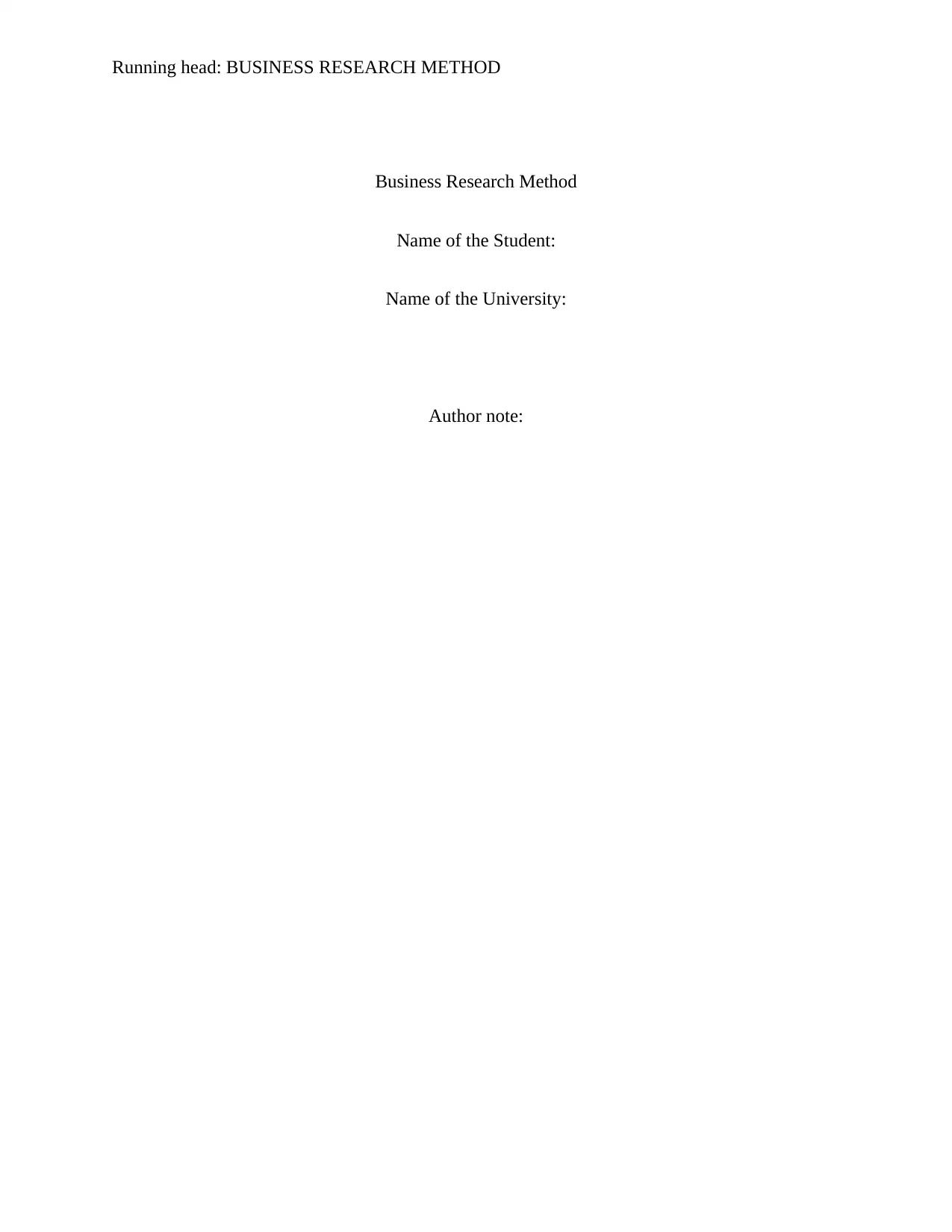
Running head: BUSINESS RESEARCH METHOD
Business Research Method
Name of the Student:
Name of the University:
Author note:
Business Research Method
Name of the Student:
Name of the University:
Author note:
Paraphrase This Document
Need a fresh take? Get an instant paraphrase of this document with our AI Paraphraser
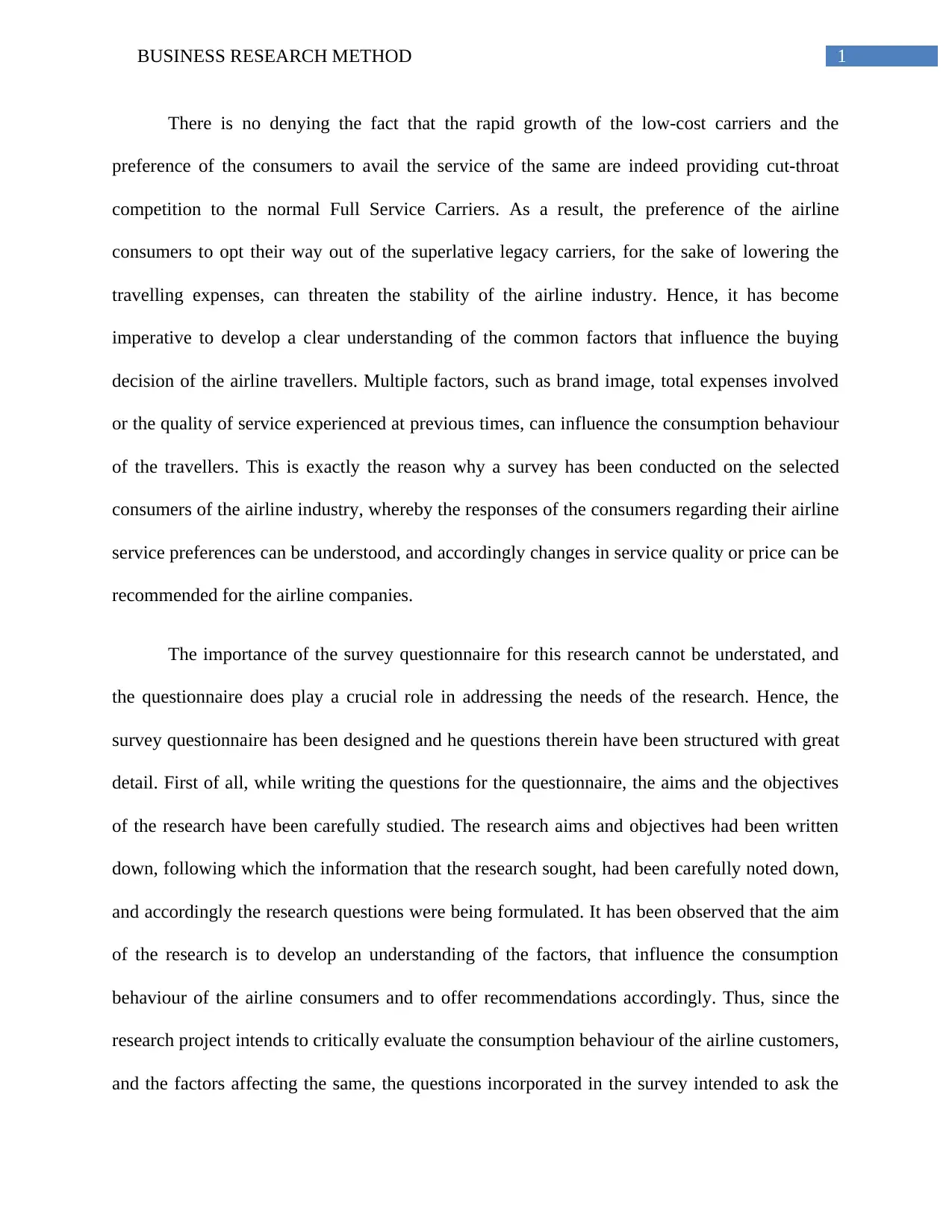
1BUSINESS RESEARCH METHOD
There is no denying the fact that the rapid growth of the low-cost carriers and the
preference of the consumers to avail the service of the same are indeed providing cut-throat
competition to the normal Full Service Carriers. As a result, the preference of the airline
consumers to opt their way out of the superlative legacy carriers, for the sake of lowering the
travelling expenses, can threaten the stability of the airline industry. Hence, it has become
imperative to develop a clear understanding of the common factors that influence the buying
decision of the airline travellers. Multiple factors, such as brand image, total expenses involved
or the quality of service experienced at previous times, can influence the consumption behaviour
of the travellers. This is exactly the reason why a survey has been conducted on the selected
consumers of the airline industry, whereby the responses of the consumers regarding their airline
service preferences can be understood, and accordingly changes in service quality or price can be
recommended for the airline companies.
The importance of the survey questionnaire for this research cannot be understated, and
the questionnaire does play a crucial role in addressing the needs of the research. Hence, the
survey questionnaire has been designed and he questions therein have been structured with great
detail. First of all, while writing the questions for the questionnaire, the aims and the objectives
of the research have been carefully studied. The research aims and objectives had been written
down, following which the information that the research sought, had been carefully noted down,
and accordingly the research questions were being formulated. It has been observed that the aim
of the research is to develop an understanding of the factors, that influence the consumption
behaviour of the airline consumers and to offer recommendations accordingly. Thus, since the
research project intends to critically evaluate the consumption behaviour of the airline customers,
and the factors affecting the same, the questions incorporated in the survey intended to ask the
There is no denying the fact that the rapid growth of the low-cost carriers and the
preference of the consumers to avail the service of the same are indeed providing cut-throat
competition to the normal Full Service Carriers. As a result, the preference of the airline
consumers to opt their way out of the superlative legacy carriers, for the sake of lowering the
travelling expenses, can threaten the stability of the airline industry. Hence, it has become
imperative to develop a clear understanding of the common factors that influence the buying
decision of the airline travellers. Multiple factors, such as brand image, total expenses involved
or the quality of service experienced at previous times, can influence the consumption behaviour
of the travellers. This is exactly the reason why a survey has been conducted on the selected
consumers of the airline industry, whereby the responses of the consumers regarding their airline
service preferences can be understood, and accordingly changes in service quality or price can be
recommended for the airline companies.
The importance of the survey questionnaire for this research cannot be understated, and
the questionnaire does play a crucial role in addressing the needs of the research. Hence, the
survey questionnaire has been designed and he questions therein have been structured with great
detail. First of all, while writing the questions for the questionnaire, the aims and the objectives
of the research have been carefully studied. The research aims and objectives had been written
down, following which the information that the research sought, had been carefully noted down,
and accordingly the research questions were being formulated. It has been observed that the aim
of the research is to develop an understanding of the factors, that influence the consumption
behaviour of the airline consumers and to offer recommendations accordingly. Thus, since the
research project intends to critically evaluate the consumption behaviour of the airline customers,
and the factors affecting the same, the questions incorporated in the survey intended to ask the
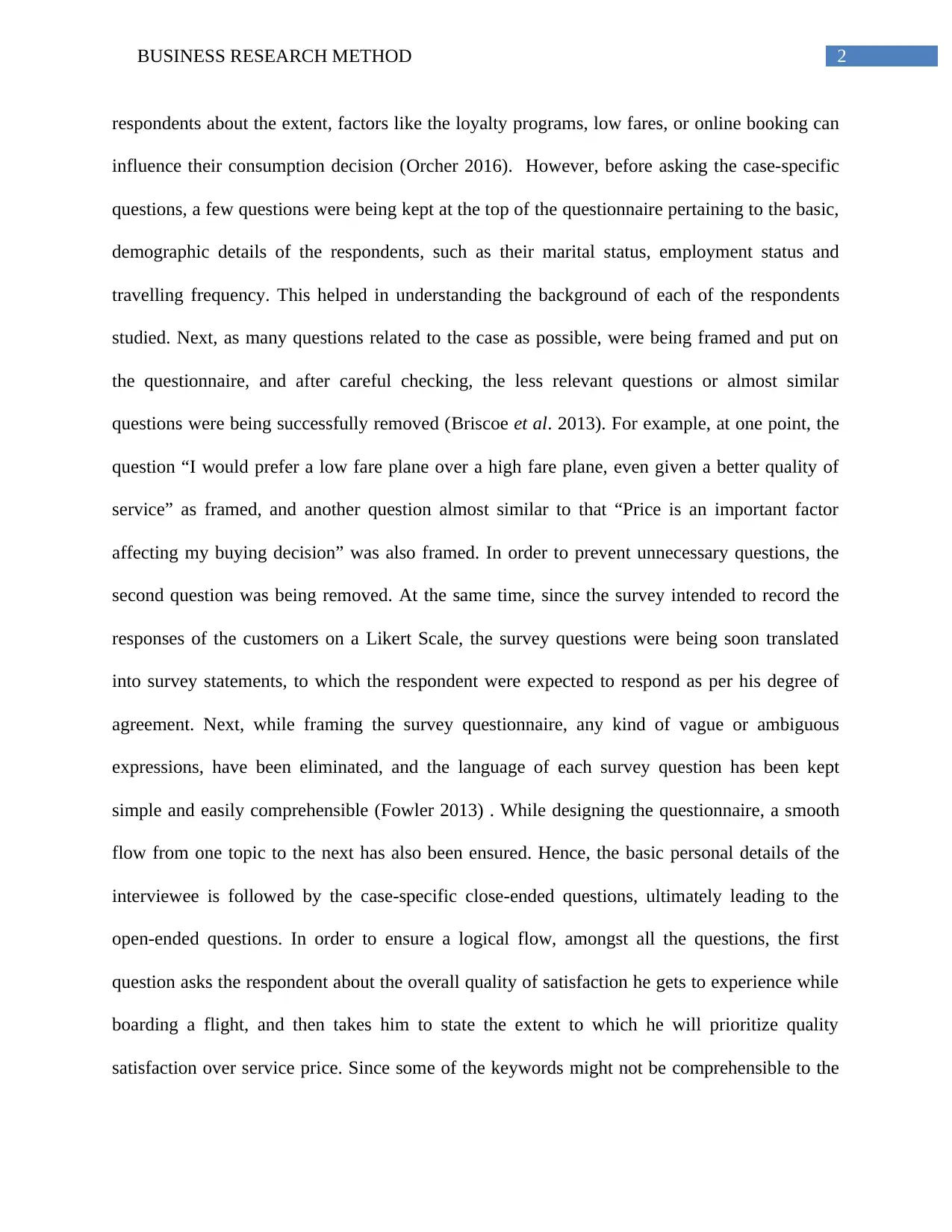
2BUSINESS RESEARCH METHOD
respondents about the extent, factors like the loyalty programs, low fares, or online booking can
influence their consumption decision (Orcher 2016). However, before asking the case-specific
questions, a few questions were being kept at the top of the questionnaire pertaining to the basic,
demographic details of the respondents, such as their marital status, employment status and
travelling frequency. This helped in understanding the background of each of the respondents
studied. Next, as many questions related to the case as possible, were being framed and put on
the questionnaire, and after careful checking, the less relevant questions or almost similar
questions were being successfully removed (Briscoe et al. 2013). For example, at one point, the
question “I would prefer a low fare plane over a high fare plane, even given a better quality of
service” as framed, and another question almost similar to that “Price is an important factor
affecting my buying decision” was also framed. In order to prevent unnecessary questions, the
second question was being removed. At the same time, since the survey intended to record the
responses of the customers on a Likert Scale, the survey questions were being soon translated
into survey statements, to which the respondent were expected to respond as per his degree of
agreement. Next, while framing the survey questionnaire, any kind of vague or ambiguous
expressions, have been eliminated, and the language of each survey question has been kept
simple and easily comprehensible (Fowler 2013) . While designing the questionnaire, a smooth
flow from one topic to the next has also been ensured. Hence, the basic personal details of the
interviewee is followed by the case-specific close-ended questions, ultimately leading to the
open-ended questions. In order to ensure a logical flow, amongst all the questions, the first
question asks the respondent about the overall quality of satisfaction he gets to experience while
boarding a flight, and then takes him to state the extent to which he will prioritize quality
satisfaction over service price. Since some of the keywords might not be comprehensible to the
respondents about the extent, factors like the loyalty programs, low fares, or online booking can
influence their consumption decision (Orcher 2016). However, before asking the case-specific
questions, a few questions were being kept at the top of the questionnaire pertaining to the basic,
demographic details of the respondents, such as their marital status, employment status and
travelling frequency. This helped in understanding the background of each of the respondents
studied. Next, as many questions related to the case as possible, were being framed and put on
the questionnaire, and after careful checking, the less relevant questions or almost similar
questions were being successfully removed (Briscoe et al. 2013). For example, at one point, the
question “I would prefer a low fare plane over a high fare plane, even given a better quality of
service” as framed, and another question almost similar to that “Price is an important factor
affecting my buying decision” was also framed. In order to prevent unnecessary questions, the
second question was being removed. At the same time, since the survey intended to record the
responses of the customers on a Likert Scale, the survey questions were being soon translated
into survey statements, to which the respondent were expected to respond as per his degree of
agreement. Next, while framing the survey questionnaire, any kind of vague or ambiguous
expressions, have been eliminated, and the language of each survey question has been kept
simple and easily comprehensible (Fowler 2013) . While designing the questionnaire, a smooth
flow from one topic to the next has also been ensured. Hence, the basic personal details of the
interviewee is followed by the case-specific close-ended questions, ultimately leading to the
open-ended questions. In order to ensure a logical flow, amongst all the questions, the first
question asks the respondent about the overall quality of satisfaction he gets to experience while
boarding a flight, and then takes him to state the extent to which he will prioritize quality
satisfaction over service price. Since some of the keywords might not be comprehensible to the
⊘ This is a preview!⊘
Do you want full access?
Subscribe today to unlock all pages.

Trusted by 1+ million students worldwide
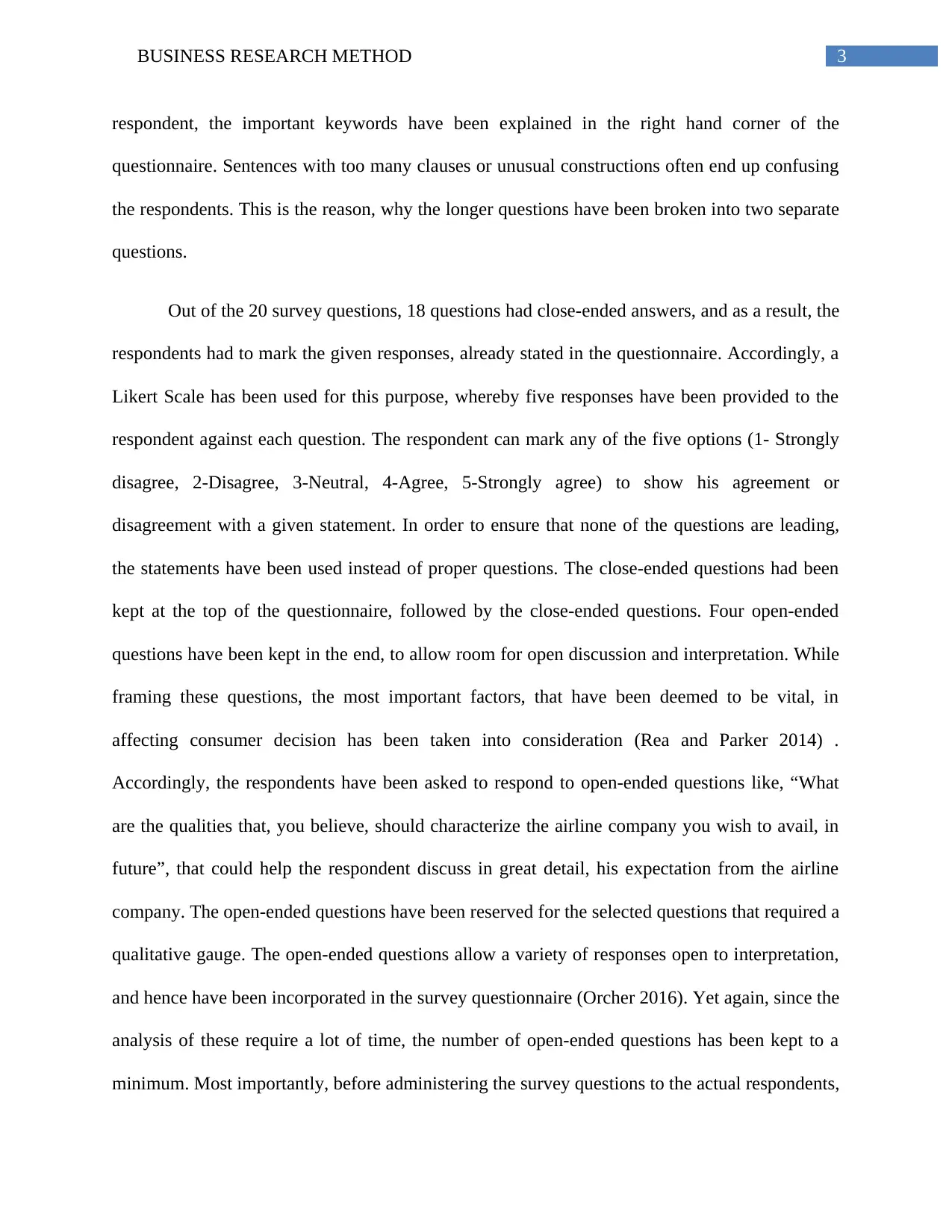
3BUSINESS RESEARCH METHOD
respondent, the important keywords have been explained in the right hand corner of the
questionnaire. Sentences with too many clauses or unusual constructions often end up confusing
the respondents. This is the reason, why the longer questions have been broken into two separate
questions.
Out of the 20 survey questions, 18 questions had close-ended answers, and as a result, the
respondents had to mark the given responses, already stated in the questionnaire. Accordingly, a
Likert Scale has been used for this purpose, whereby five responses have been provided to the
respondent against each question. The respondent can mark any of the five options (1- Strongly
disagree, 2-Disagree, 3-Neutral, 4-Agree, 5-Strongly agree) to show his agreement or
disagreement with a given statement. In order to ensure that none of the questions are leading,
the statements have been used instead of proper questions. The close-ended questions had been
kept at the top of the questionnaire, followed by the close-ended questions. Four open-ended
questions have been kept in the end, to allow room for open discussion and interpretation. While
framing these questions, the most important factors, that have been deemed to be vital, in
affecting consumer decision has been taken into consideration (Rea and Parker 2014) .
Accordingly, the respondents have been asked to respond to open-ended questions like, “What
are the qualities that, you believe, should characterize the airline company you wish to avail, in
future”, that could help the respondent discuss in great detail, his expectation from the airline
company. The open-ended questions have been reserved for the selected questions that required a
qualitative gauge. The open-ended questions allow a variety of responses open to interpretation,
and hence have been incorporated in the survey questionnaire (Orcher 2016). Yet again, since the
analysis of these require a lot of time, the number of open-ended questions has been kept to a
minimum. Most importantly, before administering the survey questions to the actual respondents,
respondent, the important keywords have been explained in the right hand corner of the
questionnaire. Sentences with too many clauses or unusual constructions often end up confusing
the respondents. This is the reason, why the longer questions have been broken into two separate
questions.
Out of the 20 survey questions, 18 questions had close-ended answers, and as a result, the
respondents had to mark the given responses, already stated in the questionnaire. Accordingly, a
Likert Scale has been used for this purpose, whereby five responses have been provided to the
respondent against each question. The respondent can mark any of the five options (1- Strongly
disagree, 2-Disagree, 3-Neutral, 4-Agree, 5-Strongly agree) to show his agreement or
disagreement with a given statement. In order to ensure that none of the questions are leading,
the statements have been used instead of proper questions. The close-ended questions had been
kept at the top of the questionnaire, followed by the close-ended questions. Four open-ended
questions have been kept in the end, to allow room for open discussion and interpretation. While
framing these questions, the most important factors, that have been deemed to be vital, in
affecting consumer decision has been taken into consideration (Rea and Parker 2014) .
Accordingly, the respondents have been asked to respond to open-ended questions like, “What
are the qualities that, you believe, should characterize the airline company you wish to avail, in
future”, that could help the respondent discuss in great detail, his expectation from the airline
company. The open-ended questions have been reserved for the selected questions that required a
qualitative gauge. The open-ended questions allow a variety of responses open to interpretation,
and hence have been incorporated in the survey questionnaire (Orcher 2016). Yet again, since the
analysis of these require a lot of time, the number of open-ended questions has been kept to a
minimum. Most importantly, before administering the survey questions to the actual respondents,
Paraphrase This Document
Need a fresh take? Get an instant paraphrase of this document with our AI Paraphraser
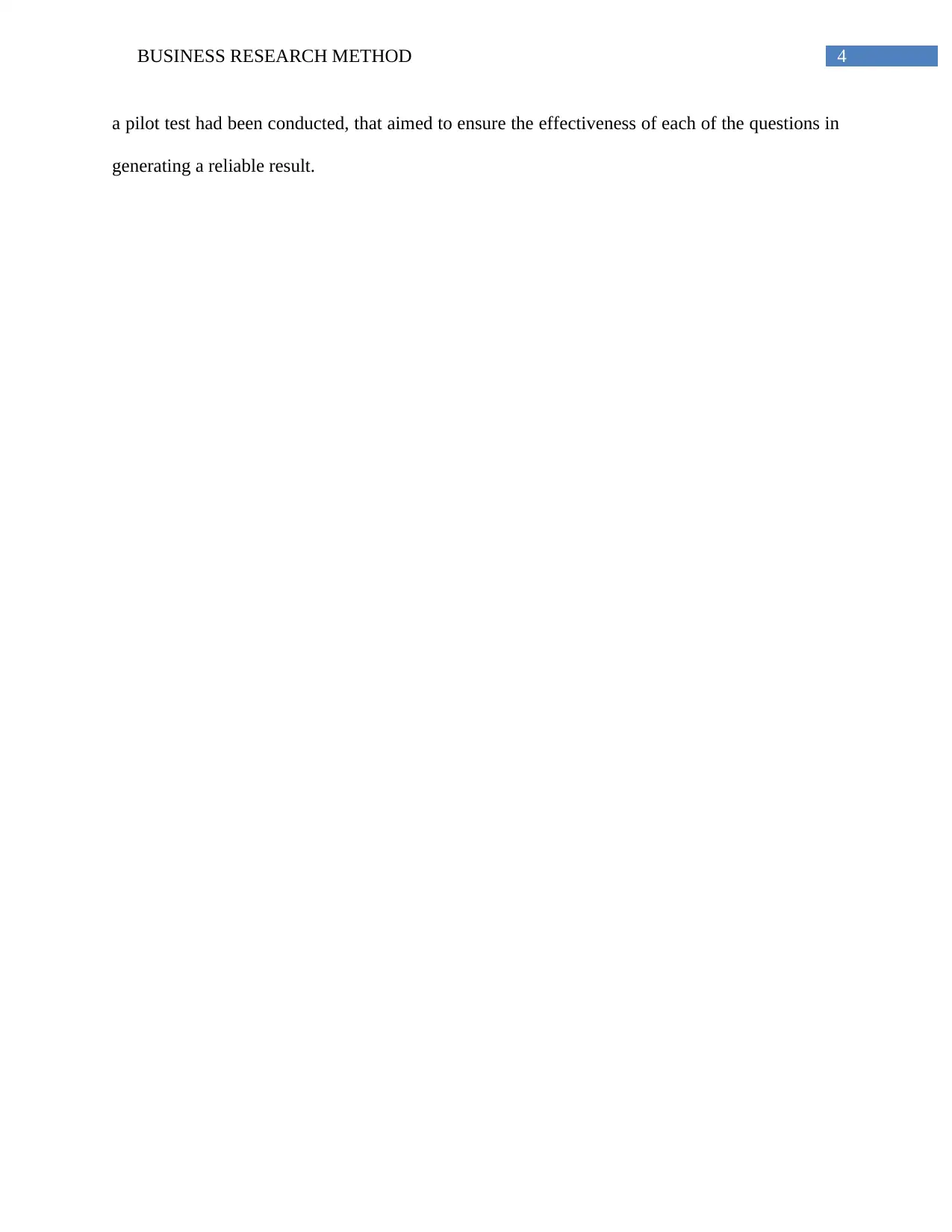
4BUSINESS RESEARCH METHOD
a pilot test had been conducted, that aimed to ensure the effectiveness of each of the questions in
generating a reliable result.
a pilot test had been conducted, that aimed to ensure the effectiveness of each of the questions in
generating a reliable result.

5BUSINESS RESEARCH METHOD
Reference List:
Briscoe, B., Brunstrom, A., Ros, D., Hayes, D., Petlund, A., Tsang, I. J., ... & Fairhurst, G.
(2013, September). A survey of latency reducing techniques and their merits. In ISOC
Workshop on Reducing Internet Latency, Sep.
Fowler Jr, F.J., 2013. Survey research methods. Sage publications.
Orcher, L.T., 2016. Conducting a survey: Techniques for a term project. Routledge.
Orcher, L.T., 2016. Conducting a survey: Techniques for a term project. Routledge.
Rea, L.M. and Parker, R.A., 2014. Designing and conducting survey research: A comprehensive
guide. John Wiley & Sons.
Reference List:
Briscoe, B., Brunstrom, A., Ros, D., Hayes, D., Petlund, A., Tsang, I. J., ... & Fairhurst, G.
(2013, September). A survey of latency reducing techniques and their merits. In ISOC
Workshop on Reducing Internet Latency, Sep.
Fowler Jr, F.J., 2013. Survey research methods. Sage publications.
Orcher, L.T., 2016. Conducting a survey: Techniques for a term project. Routledge.
Orcher, L.T., 2016. Conducting a survey: Techniques for a term project. Routledge.
Rea, L.M. and Parker, R.A., 2014. Designing and conducting survey research: A comprehensive
guide. John Wiley & Sons.
⊘ This is a preview!⊘
Do you want full access?
Subscribe today to unlock all pages.

Trusted by 1+ million students worldwide
1 out of 6
Related Documents
Your All-in-One AI-Powered Toolkit for Academic Success.
+13062052269
info@desklib.com
Available 24*7 on WhatsApp / Email
![[object Object]](/_next/static/media/star-bottom.7253800d.svg)
Unlock your academic potential
Copyright © 2020–2025 A2Z Services. All Rights Reserved. Developed and managed by ZUCOL.





